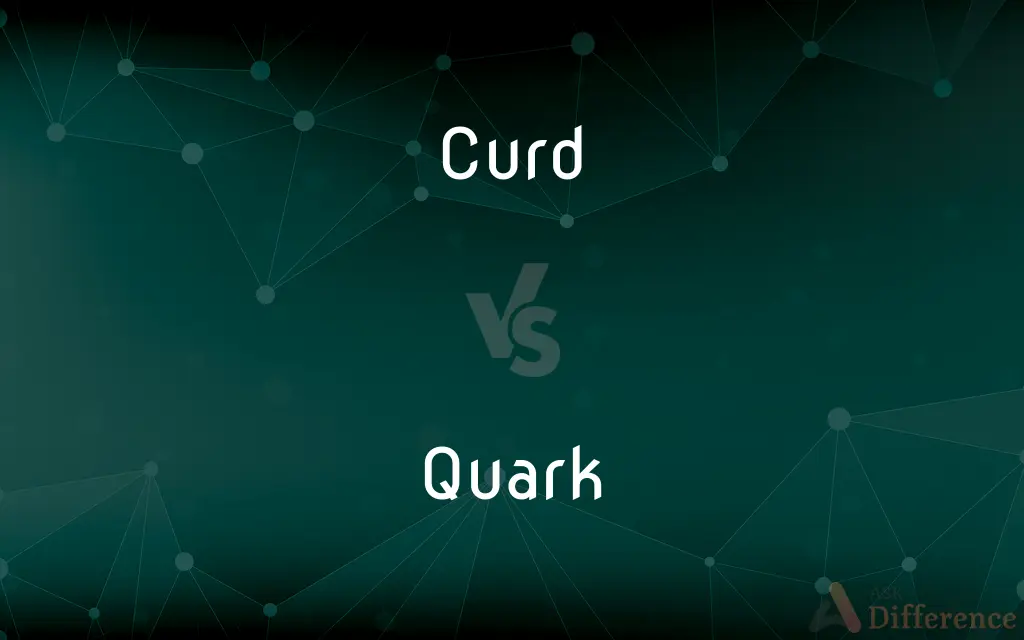Curd vs. Quark — What's the Difference?
Edited by Tayyaba Rehman — By Maham Liaqat — Updated on April 6, 2024
Curd is coagulated milk used in various cuisines, known for its versatility in dishes, while quark is a type of fresh dairy product, smooth and creamy, popular in European cuisines.

Difference Between Curd and Quark
Table of Contents
ADVERTISEMENT
Key Differences
Curd forms when milk coagulates, separating into curds and whey, a process often initiated by adding an acidic substance like lemon juice or vinegar. It's a staple in many cultures, used in dishes ranging from savory to sweet, and can vary in consistency. Quark, on the other hand, is a specific type of fresh cheese common in Central and Eastern Europe, made by warming soured milk until it curdles, then straining it. It's known for its smooth, spreadable texture and mild flavor, making it a versatile ingredient in both savory and sweet recipes.
While curd is a broader category that can include various types of coagulated milk products, quark is a distinct product within this category, with a specific texture and production process. Curd's texture and acidity can vary widely depending on the method of coagulation and the milk used, making it a diverse ingredient in culinary traditions. Quark's texture is consistently smooth and creamy, and it is less acidic than some curds, which contributes to its mild flavor profile.
In terms of nutritional content, both curd and quark are rich in proteins and calcium, but their fat content can vary significantly. Curd made from whole milk will be higher in fat, whereas quark is often available in low-fat versions, making it a popular choice for health-conscious consumers. Moreover, the specific strain of bacteria used in quark production can contribute to its probiotic properties, enhancing its health benefits.
Curd is often used in Indian and Middle Eastern cuisines, in dishes like curries and desserts, or consumed directly with sugar or spices. Quark finds its place in European cuisines, used as a base for cheesecakes, as a spread on bread, mixed into sauces, or eaten alone with fruit or honey. Despite these traditional uses, both curd and quark are increasingly crossing culinary borders, appreciated for their versatility and nutritional value.
The distinction between curd and quark lies not only in their specific characteristics and production methods but also in their cultural significance and traditional uses. While curd represents a wide range of coagulated milk products with various textures and flavors, quark is a specific type of fresh cheese with a unique, creamy texture and a mild, versatile flavor.
ADVERTISEMENT
Comparison Chart
Definition
Coagulated milk product that separates into curds and whey.
A type of fresh cheese made from warmed, soured milk that's then strained.
Texture
Can vary from firm and crumbly to soft and creamy.
Consistently smooth and spreadable.
Flavor
Can vary; often tangy or sour.
Mild and slightly tangy.
Origin
Global, used in various cuisines.
European, especially in Central and Eastern Europe.
Uses
Versatile in culinary use, from savory dishes to desserts.
Used in both savory and sweet dishes, spreads, and as a base for cheesecakes.
Nutritional Content
Rich in proteins and calcium; fat content varies by milk used.
Often available in low-fat versions; rich in proteins, calcium, and probiotics.
Compare with Definitions
Curd
Coagulated milk product.
Curd is often used in Indian cuisine to make dishes like paneer.
Quark
Type of fresh cheese.
Quark is popular in German cheesecakes.
Curd
Versatile dairy ingredient.
The curd was turned into delicious yogurt.
Quark
Smooth and creamy texture.
Quark spread on toast makes a nutritious breakfast.
Curd
Can be eaten sweet or savory.
Sweetened curd with honey is a simple dessert.
Quark
Low in fat.
Low-fat quark is favored in healthy diets.
Curd
Forms by acidification.
Adding lemon juice to milk forms curd.
Quark
Contains probiotics.
Quark can contribute to a healthy gut due to its probiotic content.
Curd
Rich in protein.
Curd is a good source of dietary protein.
Quark
Made from soured milk.
To make quark, milk is warmed and then curdled.
Curd
Curd is obtained by coagulating milk in a sequential process called curdling. It can be a final dairy product or the first stage in cheesemaking.
Quark
A quark () is a type of elementary particle and a fundamental constituent of matter. Quarks combine to form composite particles called hadrons, the most stable of which are protons and neutrons, the components of atomic nuclei.
Curd
The part of milk that coagulates when the milk sours or is treated with enzymes. Curd is used to make cheese.
Quark
Any of a class of six fundamental fermions, two in each of the three generations, one having an electric charge of - 1/3 , the other, + 2/3 , comprising the down, up, strange, charm, bottom, and top quarks. Quarks are the basic components of all hadrons.
Curd
A lump of curd
Cheese curds.
Quark
Any of the six quarks' associated antiparticles, the antiquarks.
Curd
A coagulated liquid that resembles milk curd.
Quark
A soft, creamy, usually unsalted cheese traditional to central Europe and made from cow's milk that is coagulated by the lactic acid produced by bacteria rather than by the use of rennet.
Curd
To form or cause to form into curd; curdle.
Quark
(particle) In the Standard Model, an elementary subatomic particle that forms matter. They combine to form hadrons, such as protons and neutrons. Category:en:Nuclear physics
Curd
The part of milk that coagulates when it sours or is treated with enzymes; used to make cottage cheese, dahi, etc.
Quark
An integer that uniquely identifies a text string.
Curd
The coagulated part of any liquid.
Quark
A soft creamy cheese, eaten throughout northern, central, eastern, and southeastern Europe as well as the Low Countries, very similar to cottage cheese except that it is usually not made with rennet.
Curd
The edible flower head of certain brassicaceous plants.
Quark
The black-crowned night heron, Nycticorax nycticorax.
Curd
(intransitive) To form curd; to curdle.
Quark
Hypothetical truly fundamental particle in mesons and baryons; there are supposed to be six flavors of quarks (and their antiquarks), which come in pairs; each has an electric charge of +2/3 or -1/3
Curd
(transitive) To cause to coagulate or thicken; to cause to congeal; to curdle.
Quark
Fresh unripened cheese of a smooth texture made from pasteurized milk, a starter, and rennet
Curd
The coagulated or thickened part of milk, as distinguished from the whey, or watery part. It is eaten as food, especially when made into cheese.
Curds and cream, the flower of country fare.
Curd
The coagulated part of any liquid.
Curd
The edible flower head of certain brassicaceous plants, as the broccoli and cauliflower.
Broccoli should be cut while the curd, as the flowering mass is termed, is entire.
Cauliflowers should be cut for use while the head, or curd, is still close and compact.
Curd
To cause to coagulate or thicken; to cause to congeal; to curdle.
Does it curd thy bloodTo say I am thy mother?
Curd
To become coagulated or thickened; to separate into curds and whey
Curd
A coagulated liquid resembling milk curd;
Bean curd
Lemon curd
Curd
Coagulated milk; used to made cheese;
Little Miss Muffet sat on a tuffet eating some curds and whey
Common Curiosities
What is the primary difference between curd and quark?
The primary difference lies in their production methods and consistency: curd refers to a broader category of coagulated milk products, while quark is a specific type of smooth, fresh cheese.
How are curd and quark used in cooking?
Curd is versatile, used in savory dishes, sweets, or as a standalone snack, whereas quark is often used in desserts, spreads, and sauces.
Can quark be used as a substitute for curd?
Yes, in many recipes, quark can substitute for curd, especially when a smooth texture and mild flavor are desired.
What's the best way to eat quark?
Quark can be enjoyed in numerous ways: as a spread on bread, mixed with herbs or fruits, or used as a base for cheesecakes and desserts.
Can I make quark at home?
Yes, quark can be made at home by warming soured milk until it curdles, then straining it to achieve a smooth consistency.
Are curd and quark available worldwide?
Curd is globally available due to its presence in various culinary traditions, while quark is more traditionally European but is becoming more widely available due to its growing popularity.
Do curd and quark have the same nutritional benefits?
Both are rich in proteins and calcium, but quark often has added health benefits due to its probiotic content, especially in low-fat versions.
Is quark healthier than curd?
Quark can be considered healthier in low-fat forms, providing probiotics without high fat content, but the healthiness can vary based on the specific type of curd and its fat content.
Can lactose-intolerant individuals consume quark and curd?
This depends on the individual's level of tolerance and the specific product; some low-lactose or lactose-free versions may be suitable.
Is curd the same as yogurt?
While similar, curd and yogurt differ in their bacterial cultures; yogurt is specifically fermented with yogurt cultures.
How do I choose between curd and quark for a recipe?
Consider the desired texture and flavor; use quark for a smoother, creamier consistency and a mild taste, or curd for more tang and versatility in texture.
How does the taste of quark compare to other cheeses?
Quark has a milder, less tangy flavor compared to other fresh cheeses, making it versatile in both sweet and savory dishes.
Share Your Discovery

Previous Comparison
Kaka vs. Kaki
Next Comparison
Hospitable vs. HospitalAuthor Spotlight
Written by
Maham LiaqatEdited by
Tayyaba RehmanTayyaba Rehman is a distinguished writer, currently serving as a primary contributor to askdifference.com. As a researcher in semantics and etymology, Tayyaba's passion for the complexity of languages and their distinctions has found a perfect home on the platform. Tayyaba delves into the intricacies of language, distinguishing between commonly confused words and phrases, thereby providing clarity for readers worldwide.















































